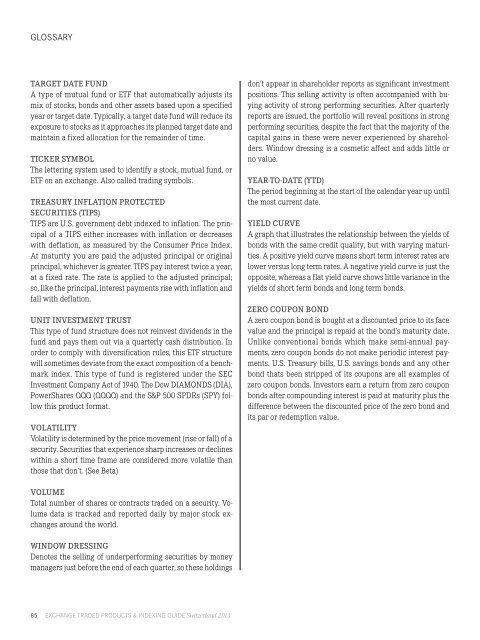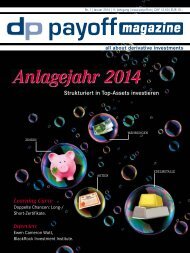You also want an ePaper? Increase the reach of your titles
YUMPU automatically turns print PDFs into web optimized ePapers that Google loves.
glossarY<br />
TARGET DATE FUND<br />
A type of mutual fund or ETF that automatically adjusts its<br />
mix of stocks, bonds and other assets based upon a specified<br />
year or target date. Typically, a target date fund will reduce its<br />
exposure to stocks as it approaches its planned target date and<br />
maintain a fixed allocation for the remainder of time.<br />
TICKER SYMBOL<br />
The lettering system used to identify a stock, mutual fund, or<br />
ETF on an exchange. Also called trading symbols.<br />
TREASURY INFLATION PROTECTED<br />
SECURITIES (TIPS)<br />
TIPS are U.S. government debt indexed to inflation. The principal<br />
of a TIPS either increases with inflation or decreases<br />
with deflation, as measured by the Consumer Price Index.<br />
At maturity you are paid the adjusted principal or original<br />
principal, whichever is greater. TIPS pay interest twice a year,<br />
at a fixed rate. The rate is applied to the adjusted principal;<br />
so, like the principal, interest payments rise with inflation and<br />
fall with deflation.<br />
UNIT INVESTMENT TRUST<br />
This type of fund structure does not reinvest dividends in the<br />
fund and pays them out via a quarterly cash distribution. In<br />
order to comply with diversification rules, this ETF structure<br />
will sometimes deviate from the exact composition of a benchmark<br />
index. This type of fund is registered under the SEC<br />
Investment Company Act of 1940. The Dow DIAMONDS (DIA),<br />
PowerShares QQQ (QQQQ) and the S&P 500 SPDRs (SPY) follow<br />
this product format.<br />
VOLATILITY<br />
Volatility is determined by the price movement (rise or fall) of a<br />
security. Securities that experience sharp increases or declines<br />
within a short time frame are considered more volatile than<br />
those that don’t. (See Beta)<br />
VOLUME<br />
Total number of shares or contracts traded on a security. Volume<br />
data is tracked and reported daily by major stock exchanges<br />
around the world.<br />
WINDOW DRESSING<br />
Denotes the selling of underperforming securities by money<br />
managers just before the end of each quarter, so these holdings<br />
85 ExchangE TradEd ProducTs & IndExIng guIdE <strong>Switzerland</strong> <strong>2013</strong><br />
don’t appear in shareholder reports as significant investment<br />
positions. This selling activity is often accompanied with buying<br />
activity of strong performing securities. After quarterly<br />
reports are issued, the portfolio will reveal positions in strong<br />
performing securities, despite the fact that the majority of the<br />
capital gains in these were never experienced by shareholders.<br />
Window dressing is a cosmetic affect and adds little or<br />
no value.<br />
YEAR-TO-DATE (YTD)<br />
The period beginning at the start of the calendar year up until<br />
the most current date.<br />
YIELD CURVE<br />
A graph that illustrates the relationship between the yields of<br />
bonds with the same credit quality, but with varying maturities.<br />
A positive yield curve means short term interest rates are<br />
lower versus long term rates. A negative yield curve is just the<br />
opposite, whereas a flat yield curve shows little variance in the<br />
yields of short term bonds and long term bonds.<br />
ZERO COUPON BOND<br />
A zero coupon bond is bought at a discounted price to its face<br />
value and the principal is repaid at the bond’s maturity date.<br />
Unlike conventional bonds which make semi-annual payments,<br />
zero coupon bonds do not make periodic interest payments.<br />
U.S. Treasury bills, U.S. savings bonds and any other<br />
bond thats been stripped of its coupons are all examples of<br />
zero coupon bonds. Investors earn a return from zero coupon<br />
bonds after compounding interest is paid at maturity plus the<br />
difference between the discounted price of the zero bond and<br />
its par or redemption value.

















